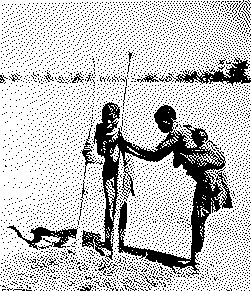
As mentioned earlier, all labor energy involved in Tonga agriculture is human labor. There are no mechanized cultivation or processing aids, not even draft animals to drag a plow or grinding wheel. As a result, a good measure of the productive potential of an individual rests on the amount of other people's labor they can count on. Husbands have access to the labor of their wives and children, women have access to the labor of their children.

Tasks that require more labor than that to which a person has direct access requires an exchange. Thus, you might ask your brothers and other relatives to help in clearing a new field. In exchange you feed them a meal, perhaps brew some beer for them. In the long run, by helping you they have ensured that you will help them when they need assistance -- either with your labor, or with food if something should happen to their crops. Regardless of the amount of land an individual may own, if they do not have the labor resources to adequately guard it from predators, or to weed it, or to harvest the crop, they still may not be able to adequately feed themselves and their family. Conversely, someone with plenty of available labor, but insufficient land will have the same problem of not being able to fully take advantage of the available resources.
Among the Valley Tonga, each adult generally has ownership of one or more fields. Thus husbands and wives each have their own fields. Wives work in their husband's fields as well as cultivating their own. Their children are available labor for both sets of fields. Both husbands and wives also retain individual ownership of the products of their fields. Both have their own storage facilities. Wives feed their children, their husbands, and themselves from their stores until they run out. When the wife's stores do run out, she must then call on her husband to provide food from his stores to feed the family until the next crop is ready for harvest. The husband in turn can call on other relatives for food if his stores run out - provided that they have sufficient food to share. Thus, although individuals are essentially responsible for producing sufficient food for themselves and their immediate labor pool, there is a social safety net in the event of natural calamities such as ruined crops, elephant attacks, etc.
The problem with this system, and this is generally true of all subsistence farming societies in semi-arid environments, is that it does a good job of mitigating the effects of localized calamities. On the other hand, more general catastrophes such as long term droughts affect everyone in the network so that when one person runs out of food and begins depleting other people's food supplies (in an environment where everyone's productivity is now lower) the entire system can become swamped very quickly and general famine ensues. As you will see in the simulation, while things are good everything works fine, but when things get bad, they deteriorate very rapidly and people start dying.
|
|
|
|